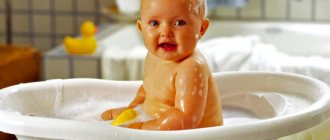There are certain signs by which you can determine that a child has health problems. If a 5-year-old girl has yellow discharge, should she sound the alarm and take her daughter to the doctor, or is this still normal?
Yellow discharge in a 5-year-old girl is a kind of signal about the possible development of certain diseases. Moms pay attention to their appearance very quickly, since in this case the panties get very dirty. Normally, girls 5 years old should have virtually no vaginal discharge, or it should be quite scanty, transparent, and odorless. When something in the state of the body changes, they become thicker, acquire a yellowish or even grayish, greenish tint and an unpleasant odor.
What could be causing the appearance of discharge? An accurate diagnosis can only be made by a doctor after a thorough examination. It includes an external examination of the genital organs, as well as taking a smear and urine test. It is also important to collect anamnesis, as well as assess the general state of health.
The appearance of yellow discharge with a very pungent and unpleasant odor most often indicates the development of bacterial vaginosis. This disease often affects girls aged 10-12 years, but sometimes it also affects preschoolers. It can be triggered by factors such as:
Frequent acute respiratory infections;
Poor nutrition;
Hormonal disorders;
Failure to comply with personal hygiene rules;
Obesity, diabetes.
If, in combination with the appearance of discharge, redness of the child’s external genitalia and itching in this area are observed, we are talking about the development of a disease such as vulvovaginitis.
Vulvovaginitis is caused by pathogens such as streptococcus, E. coli, and staphylococcus. To avoid such problems, you need to thoroughly wash children's underwear and iron them with a hot iron on both sides after drying.
This disease is often diagnosed in girls aged 5-7 years. At this age and before the onset of puberty, there are no lactic acid bacteria in the vagina, which serve as a kind of protection against pathogenic microflora. Combined with a weakened immune system, this creates an ideal environment for microbes to multiply. Vulvovaginitis can also be of viral origin. In this case, very severe pain occurs when urinating.
Vulvovaginitis can develop for a number of reasons, including:
Infection in the vagina;
Exposure to chemicals (incorrect soap);
Mechanical damage to the vaginal mucosa.
Girls aged 5 years often study the genitals and cases when a foreign body is found in the vagina are not isolated. Infectious contamination can occur due to helminthic infestations, swimming in dirty ponds, as well as sitting on the floor without underwear, wearing tight panties and not changing them often enough.
What to do if a child has yellow discharge and other unpleasant symptoms? To begin with, you should remember that self-medication in such a situation is absolutely unacceptable. The girl needs to be shown to a doctor as quickly as possible, and if a foreign body is suspected of entering the genital tract, this must be done immediately.
Treatment depends on what diagnosis is made. Typically, specialists prescribe antibiotics to suppress pathogenic microflora. Vitamins may also be recommended to strengthen the immune system.
If yellow discharge appears, you should bathe the girl exclusively in clean water with the addition of medicinal herbs such as chamomile and celandine. It is also useful to take sitz baths 1-2 times a day for 2 weeks.
Yellow vaginal discharge is not normal for a 5 year old girl. This sign may indicate the development of vulvovaginitis or bacterial vaginosis. Both of these conditions require proper treatment. The sooner the child gets help, the better.
Yesterday evening I discovered a yellowish-brownish stain on my daughter’s (3.5 years old) panties. I examined the genitals - the discharge was visible even after washing, in color, consistency and smell - like a woman at the very end of her period, that is, a slight smell of blood, there was no other shade of smell - unpleasant. And to my surprise, I discovered that the vaginal lips were unstuck - before that there were synechiae. He says it hurt to urinate once, yesterday - at the very beginning of urination, but then it didn’t hurt. Today there is the same abundant spot, well, just like barely smeared menstruation, but today there is no mucus (yesterday there was).
Could this be the result of disunion of synechiae? (although I don’t understand how - the discharge is clearly from inside the vagina, and not from above, where the rupture could have occurred..). What else could it be?
We made an appointment with the gynecologist, but it will be in 3 days. And, of course, I want to be armed, not take unnecessary tests, traumatizing the child, and not take unnecessary medications. And in general, I’m worried. Maybe we should take some measures now, baths?
Answered by Berezovskaya E.P.
First of all, it is necessary to exclude (or confirm) trauma, including sexual trauma. Therefore, collect a detailed history of who the girl was with, whether she injured her genitals with a toy, whether someone inserted something or any objects into her vagina, whether she fell or hit her external genitalia. If a girl says that someone touched her organs, immediately see a doctor. Also exclude worms. Rule out hormonal ovarian tumor. DO NOT use ANYTHING in terms of self-medication, including baths.
Our site cooperates with certified specialists in the field of obstetrics, gynecology and reproduction. Ask your question in the comments and receive an answer within 48 hours.
Most gynecologists note that the vast majority of the population classifies any type of discharge in girls of different ages as a pathology, considering them unacceptable before the onset of sexual activity. In fact, parents may notice the presence of vaginal secretions from the birth of their child. There is no need to be scared here, but it is better to figure out what and when is considered normal, and where it would not hurt to visit a doctor to prescribe the appropriate treatment.
The nature of vaginal secretion
Small vaginal discharge is typical for females of any age, even for infants and infants. Such white discharge is the result of spontaneous cleansing of the vaginal microflora.
The components of vaginal secretion in women are:
- epithelial cells that make up the vaginal mucosa wall;
- mucus produced by the glands of the cervix;
- microorganisms;
- blood cells (leukocytes) and other components.
In a little girl, discharge can be physiological or pathological.
It's good when everyone is healthy
Normal discharge in girls of different ages
Sometimes parents notice vaginal secretions during the newborn period. Don’t worry, but figure out what is considered normal discharge and when you need to visit a pediatric gynecologist.
Serious conversations
Up to one year old
In a 6-month-old girl, discharge is the result of the activity of the reproductive system and the cleansing of the vagina from pathological microorganisms. Normally, clear mucus with thread-like elements is secreted.
1-2 years
Starting at the age of 1 month, a girl’s sexual development begins a period of rest. Sex hormones are present in minimal quantities, the cervical glands do not function, so nothing should be released during this period. The duration of this period continues until the age of 8 years, when a new stage arrives - the prepubertal period, and the restructuring of the body begins under the influence of hormones. A year before menstruation, the girl has physiological discharge.
A child is 5-6 years old
The reproductive system is not functioning now, so a girl 2-6 years old should not have any discharge. At this time, vaginal diseases often occur, for which there are reasons:
- Immature immune system.
- Anatomical features of the body.
Therefore, orange discharge in 4- and 5-year-old girls indicates an inflammatory process.
Girl 7-8 years old
After a long pause of 7 years, the next stage of sexual development begins - puberty, and leucorrhoea is released again. This is explained by hormonal changes in the body, which prepares the body for the menstrual cycle.
Such discharge has a viscous mucous structure and does not smell.
See an endocrine system specialist
Doctors' recommendations
Let's look at what doctors advise:
- wash the girl every morning and evening. Babies under 1 year of age should be washed after each bowel movement;
- washing is carried out from front to back so that intestinal microflora does not enter the vagina;
- use soap when absolutely necessary, because it contains alkaline components that destroy the protective fat layer;
- do not use washcloths and sponges that damage the baby’s skin;
- after washing the genitals, blot the towel rather than rub it;
- change underwear daily.
About the author: Borovikova Olga Igorevna
Most gynecologists note that the vast majority of the population classifies any type of discharge in girls of different ages as a pathology, considering them unacceptable before the onset of sexual activity. In fact, parents may notice the presence of vaginal secretions from the birth of their child. There is no need to be scared here, but it is better to figure out what and when is considered normal, and where it would not hurt to visit a doctor to prescribe the appropriate treatment.
What is discharge in girls and what is its norm?
The mucus or liquid secreted from the vagina of a girl, as well as an adult woman, is called sexual secretion, vaginal discharge and leucorrhoea.
From a physiological point of view, normal discharge in a girl, regardless of age, differs in the following characteristics:
- have an almost uniform mucous consistency (not watery);
- almost transparent;
- light, slightly white;
- odorless, slightly sour due to the vaginal environment;
- not accompanied by unpleasant sensations;
- indicated in small quantities.
The presence of such marks on a child’s underpants should not cause concern. The reproductive system of any person will develop gradually, and these changes are inevitable. It is impossible to say exactly what time discharge begins in girls. Heredity, body characteristics, and other related factors are taken into account.
It is generally accepted that girls should have no discharge until puberty. But the onset of puberty does not have a clear framework and depends on many factors.
In a 10-12 year old girl, discharge on her panties may not indicate abnormalities if their appearance corresponds to the norm. Perhaps the child began puberty much earlier, and this is how the body prepares for serious restructuring and menarche. It wouldn’t hurt to contact a gynecologist to be on the safe side and get tested, but panic will be inappropriate, since at this time the child reacts very sharply to the world around him and may misperceive the concerns of his father and mother.
Parents almost always sound the alarm, worrying about discharge in newborn girls, not knowing what it means, and attribute this process to a pathological phenomenon. But vaginal secretions that are light in color and have a mucous consistency are considered normal.
In some situations, there is very little blood in the mucus. There is no need to worry, because from a medical point of view, this phenomenon is safe and is considered the so-called sexual crisis of newborns. Find out about this in one of our articles.
What to do if there is odorless purulent discharge on your panties
Purulent discharge is not normal. You need to urgently go to the hospital to find out the causes and treatment of the pathology. Common reasons include:
- inflammatory process in the ovaries;
- colpitis;
- inflammation of the cervix;
- infectious diseases.
If you experience the following symptoms, you should consult a doctor:
- thick discharge with pus;
- foul odor;
- itching of the genitals;
- there is a burning sensation;
- heat.
The gynecologist will examine the child and prescribe vaginal smears.
We look for problems by color and smell
Each disease progresses differently in all patients. There are cases when symptoms practically do not appear, and mild discomfort occurs only with the next exacerbation. The following information will help parents timely track unwanted changes in vaginal secretions and take appropriate measures.
White discharge in girls
Most often, the presence of white discharge in girls is considered normal, provided that all other characteristics of the fluid meet physiological criteria. But if the secretion resembles the consistency of cottage cheese, and the child complains of itching and burning in the area of the external genitalia, then thrush cannot be ruled out, even at 9-11 years of age and earlier.
A fungal disease can be transmitted from the mother during birth, and occur due to the use of antibiotics, as well as a general weakening of the body. Then parents may notice white discharge on their daughter’s panties
Increased attention is required at a very young age, because children at 2 or 3 years old often cannot describe their sensations
Green and yellow discharge in girls
The cause of yellow-green discharge is often bacterial vulvovaginitis, which is also called bacterial vaginosis or vaginal dysbiosis
It is important to understand the situation here. For example, a 4-year-old girl’s discharge is yellow-green, there is an unpleasant fishy smell, the child began to be capricious while washing, constantly scratching the area of the labia, where there is redness
Vaginal secretions that have a yellow tint do occur and are not associated with pathological processes, but only if your child is approaching puberty and does not experience discomfort. Although the cause of yellowish discharge in a 7-year-old child is unlikely to be the approach of menarche. According to gynecologist statistics, children under 8 years of age are at risk. The fact is that the vaginal microflora still lacks lactobacilli, which protect the body from infection.
In addition, the following can cause yellow discharge in a girl aged 5 years and at any other age:
- worms;
- dirt getting into the vagina;
- intimate hygiene products;
- foreign objects inside;
- improper swaddling;
- irritation from synthetics;
- Diaper rash.
If a yellow tint to the secretion is still acceptable, then greenish discharge, be it at any age, 2 years, 6 or 15 years, requires medical observation, smears and other necessary diagnostic methods.
Red and brown discharge in a girl
First you need to make sure it's not your period. Sometimes brown, bloody, or even purulent discharge may be seen in teenage girls' underwear if a foreign body is present in the vagina. An unpleasant and sometimes even foul odor cannot be ruled out.
Often the cause of secretion with blood is inflammatory processes, the presence of which may indicate gynecological diseases. But most often, spotting, even with a brown tint, indicates the approach of a teenager’s first menstruation and hormonal fluctuations.
Pus present
Purulent discharge in girls can never be considered normal. Here you need to quickly go to the hospital and undergo an examination, because any disease is easier to treat at the very beginning, preventing the development of a chronic form.
- colpitis;
- inflammation of the ovaries;
- inflammation of the cervix;
- infectious diseases.
You should immediately go to the hospital if you have the following symptoms:
- purulent discharge of a liquid or thick nature;
- the presence of an unpleasant and even fetid odor;
- genitals constantly itch;
- there is a tingling and burning sensation;
- elevated body temperature.
At the hospital, the gynecologist will conduct an examination and prescribe a microscopic examination of vaginal smears.
Main symptoms of pathologies
Green discharge in girls is not the only symptoms of the inflammatory process. Other signs include:
- redness of the genitals and nearby areas of the skin;
- swelling;
- burning and itching that does not go away but intensifies with urination.
The discharge of yellow-green mucus in 3-year-old girls indicates bacterial vulvovaginitis.
Carefree childhood
If the vaginal microflora of a girl aged three to four years is disturbed, a creamy gray leucorrhoea with a rotten fishy odor appears.
A 14-year-old girl develops foamy discharge due to trichomonas infection.
Allergic vulvovaginitis provokes watery leucorrhoea, while the mucous membrane is dry.
We look for problems by color and smell
Normal discharge in girls should not cause discomfort or discomfort. Foreign odor, inclusions, pain during discharge of leucorrhoea can indicate the development of a serious pathology and parents need to be extremely careful and understanding about this problem.
White discharge
Typically, white discharge is not a pathology and is present in girls of any age and in women. However, in cases where the leucorrhoea looks like cottage cheese, has inclusions and lumps, as well as a foreign smell of sour milk, this is thrush, or candidiasis. This fungal disease is accompanied by itching and burning and spreads quickly if left untreated. Young children cannot always say how they feel, so parents need to be attentive and monitor the child’s behavior and health.
Green and yellow discharge
Most often, leucorrhoea with a greenish or yellowish tint is the first sign of bacterial vulvovaginitis. If a child constantly touches the labia, wanting to comb them, it is unpleasant for him to be in the water while swimming and there is redness in the intimate area, there is a pathology.
This disease usually occurs in preschool children. The reason for this phenomenon is that in the intimate area there are no lactobacilli that create a barrier to the genitals from infectious diseases.
Leucorrhoea with a yellowish tint may not always indicate inflammatory processes in the body. Often the causes are infection with worms, dirt, foreign objects entering the genitals, an allergic reaction to fabric or diaper rash.
This pathology requires diagnosis and clarification of the causes of development.
Red and brown
This phenomenon may signal the onset of menstruation. However, in the case of a foreign body inside the genital organ, reddish and brown smears may also appear on the underwear, which have the smell of rotten meat. In this case, the child requires immediate help from a gynecologist, since this symptom indicates the development of an inflammatory process.
If there is a restructuring of hormones, you can observe the appearance of red discharge; as a rule, they signal the imminent onset of menstruation.
Pus present
Leucorrhoea, which includes pus, is not the norm for females of any age.
The most common causes are colpitis, inflammatory processes in the cervix and ovaries, as well as diseases caused by infection.
Slime or foam
Mucous or abundant foamy discharge of a pathological nature is most often a symptom of gardnerellosis. Occurs as a result of a violation of the vaginal microflora. The causes of the disease may be infections of the genitourinary system, long-term treatment with antibiotics, and hormonal imbalances.
The main symptom is the appearance of foamy or mucous discharge with an unpleasant odor, as well as pain when urinating.
Diagnostics of the child's body
Diagnosis of diseases accompanied by pathological discharge from the genital organs is carried out by a pediatric gynecologist. This doctor prescribes a number of studies and tests:
- general blood analysis;
- a vaginal smear to identify the bacteria that caused the inflammation;
- Analysis of urine;
- stool analysis to determine dysbacteriosis and worms;
- examination of the genitals for the presence of a foreign object;
- blood for hormones;
- PCR, which detects the type of pathogen and the presence of antibodies to these agents in the blood.
To clarify the causes of pathology
First aid
You cannot self-medicate - in this case you can provoke complications:
- development of chronic inflammatory diseases;
- menstrual irregularities;
- women's diseases;
- bleeding during pregnancy in the cycle in adulthood.
The mother must immediately take the child to a gynecologist, who will conduct an examination, take smears and tests. If necessary, the doctor will refer you to other specialists: a pediatrician, an endocrinologist, etc. To reduce the likelihood of leucorrhoea, Dr. Komarovsky advises monitoring girls’ hygiene:
- always wash your hands with soap after using the toilet and going outside;
- wash children's clothes separately with special powder or laundry soap;
- Teach your child proper nutrition, buy more vegetables and fruits.
Individual treatment
If the pathology is detected in a child at 6 years old, then it can be treated using the following methods:
- if necessary, remove foreign bodies that irritate the vaginal mucosa;
- as soon as the type of pathogen is determined, local or general therapy is carried out with medications. Each case requires an individual approach to treatment in accordance with the characteristics of the disease, medical history and at what age the pathologies begin. Antifungal, antibacterial and antiviral agents are prescribed as medications;
- Once a helminthic infestation has begun, all family members, except a newborn boy or girl, are also treated. This must be done to prevent re-infection;
- in case of hormonal imbalance, hormonal therapy is prescribed;
- Foods that provoke allergies are excluded from the child’s diet;
- local therapy is prescribed from baths and washings with antiseptic solutions and herbal decoctions. Sometimes ointments or creams are prescribed;
- Regular changes of underwear contribute to a speedy recovery;
- for acute pain and bleeding, bed rest may be required;
- if bleeding is caused by diseases of the urinary system, then antibiotic therapy is prescribed. You will also need to comply with the drinking regime: drink at least 2 liters of water per day, including fruit drinks and decoctions.
When mom is nearby, nothing is scary
Medication methods
Why there is pathological discharge in girls at 3 or 5 years old is determined by the doctor by conducting medical tests. After which he prescribes drug therapy. This treatment is aimed at eliminating the causative agent of the disease and normalizing the intestinal microflora.
Depending on what kind of discharge appears, the doctor prescribes various medications:
| Viferon | 1 suppository 2 times/day daily. The course of therapy is 5 days. |
| Bactisubtil | Children under 3 years of age – 2-3 capsules/day. For a child over 3 years old – from 3 to 6 capsules/day. Adolescents over 14 years old - from 2 to 4 times a day, 2 capsules per dose. The course of therapy is from 7 days. |
| Depanthol | Apply a thin layer to the affected area of skin 2 times/day. The course of treatment is 1 week. |
Follow your healthcare professional's advice
ethnoscience
Recipes from the people are aimed at eliminating the disease, the symptoms of which are leucorrhoea. Douching, suppositories and baths are used as local treatment.
- Take 100 grams of pine buds and 10 liters of boiling water. Pour boiling water over the herb, keep on low heat for half an hour and leave for another 1 hour under the lid. Add the decoction to the bath when bathing. You can buy pine extract.
- Take 15 grams of juniper and 1 tablespoon of boiling water. Pour boiling water over the herb and leave covered for 4 hours. Take 1 tbsp. 3 times/day.
Age characteristics of the genital organs of girls and adolescent girls
Children's genitals have a number of anatomical and physiological features that do not always allow them to adequately resist the infectious process. Common features include:
- weak closure of the labia minora and majora in the posterior regions;
- the mucous membrane has a small number of folds;
- the epithelium of the reproductive tract is thinned, cell reproduction and renewal are slow;
- low level of humoral protection factors (interferons, etc.) in vaginal secretions;
- coccal flora predominates;
- The baby's vagina has a neutral or alkaline pH level.
Features of the microflora of the genital organs in girls, depending on age and hormonal levels, are reflected in Table 1.
The newborn period directly depends on the maternal hormones supplied to the baby through the placenta. The mother's estrogens stimulate the epithelial cells of the girl's vagina, which mature, become keratinized, accumulate glycogen, and, in general, function like those of an adult woman. The vagina is populated with lactoflora, which protects the mucous membranes from the proliferation of pathogens. Lactobacilli produce hydrogen peroxide, stimulate the formation of interferon and immunoglobulins, due to which vulvovaginitis practically does not occur in girls in the first three weeks of life.
The “neutral” period begins after the 20th day of life and lasts until 8–9 years. The level of maternal hormones decreases, the epithelium becomes thinner, lactobacilli disappear, the pH shifts (weakly alkaline or neutral), and the genital mucosa becomes populated with coccal and bacillary flora.
Beginning of puberty. On average, puberty begins at 9 years of age. The production of estrogens is triggered, under the influence of which the vaginal epithelium changes. The cells mature, glycogen accumulates in them, the mucous membrane is populated with lactobacilli, the pH shifts to the acidic side (slightly acidic reaction).
Adolescence. By age 13, estrogen levels continue to rise, approaching adult female levels. Stimulation of the epithelium by estrogen leads to its further maturation, the proliferation of lactobacilli, and the reaction of the environment is acidic.
Table 1
Composition of vaginal microflora and pH dynamics in children of different ages
| Age | Vaginal microflora | pH of the environment |
| First hours of life | sterile | |
| First day | coccal flora | |
| 2nd - 3rd day | predominance of lactobacilli, a small amount of coccal flora | sour |
| 20th day – 9 years | There are no lactobacilli, the flora is coccal-bacillary | neutral or slightly alkaline |
| 9 – 12 years | lactobacilli in small quantities | slightly acidic |
| over 12 years old | lactobacilli predominate | sour |










